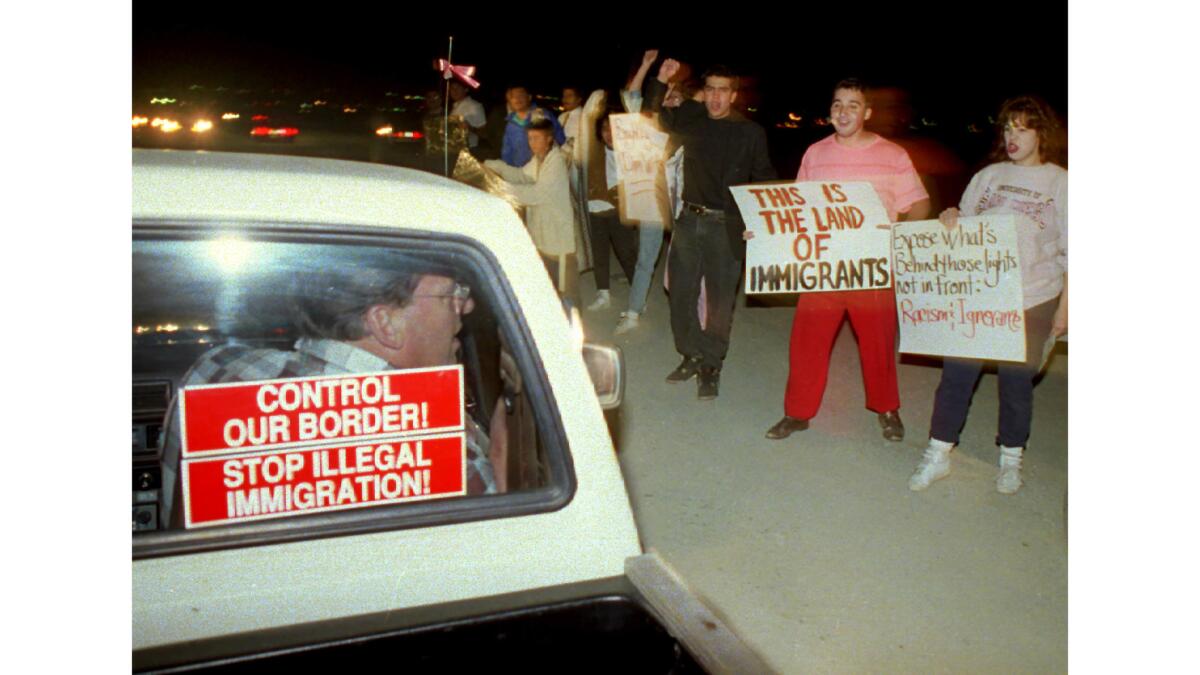From the Archives: Light Up the Border protests

During the winter of 1989-90, anti-immigration protesters started parking their vehicles near the United States-Mexico border and shining headlights into Mexico. Following one large so-called Light Up the Border protest, writer Patrick McDonnell reported in the May 26, 1990, Los Angeles Times:
SAN DIEGO – As dusk fell on the U.S.-Mexico border Thursday, hundreds of motorists gathered along a roadway and shined their headlights toward groups of uninterested migrants waiting patiently for nightfall at the boundary line.
Facing directly into the harsh beams of light, counter-protesters chanting, “No mas racismo!” (No more racism!) held up mirrors and sheets of dark plastic in an attempt to reflect the lights back to the north.
With the chill of night closing in, the face-off disintegrated into alternating volleys of epithets, as shouts of “Nazis!” and “Wetback lovers!” were exchanged.
The dissonant scene was from the latest gathering of the Light Up the Border campaign, a burgeoning movement of mostly Anglo citizens that has galvanized public attention on the continuing stream of undocumented immigrants from the south. The lighting movement, which began with small gatherings last winter, has expanded rapidly and grown into huge, highly publicized protests involving 1,000 or more people, energizing supporters and opponents on both sides of the frontier.
Despite their many disagreements, the participants and counter-protesters agree on one thing: U.S. laws, specifically the much-ballyhooed Immigration Reform and Control Act of 1986, have failed abysmally in a primary goal — turning back the daily tide of undocumented humanity from Mexico and elsewhere. Visual testament is provided by the hundreds of migrants — men and women, the old and the young — who stage each day along the international line in San Diego, waiting to slip into California and its promise of jobs.
The emotions evident during Thursday’s border protests underline what appears to be an ever-greater polarization about unauthorized immigration.”I feel hatred is brewing on both sides,” said Elizabeth Sisco, a photographer and professor at Southwestern College in Chula Vista who has been involved in border issues for more than a decade. “When people start hurling negative statements back and forth at each other, they just get madder and madder. And mad people don’t act rationally.”
How to deal with the immigration problem remains a fiercely contested challenge. The so-called Alliance for Border Control, organizer of the lighting protests, hopes the movement will prompt U.S. authorities to bolster enforcement by posting additional border guards, building more barriers, deploying National Guard troops, and implementing similar stratagems. Opponents say such steps will never work without efforts to improve the economies of Third World “sending” nations, especially Mexico, and parallel moves to allay civil strife in Central America and elsewhere. …
McDonnell’s full report is online: Tactic of Lighting Up Border Raises Tensions.
The Light Up the Border movement was started in 1989 by Muriel Watson, a former public information officer for the Border Patrol Union. According to her 2012obituary in the San Diego Union-Tribune, “Mrs Watson attended the 1994 ceremony when the Border Patrol flipped the switch on 62 stadium-style lights strung along a two-mile stretch of the previously unlit border fence.”

See more from the Los Angeles Times archives here
More to Read
Start your day right
Sign up for Essential California for news, features and recommendations from the L.A. Times and beyond in your inbox six days a week.
You may occasionally receive promotional content from the Los Angeles Times.






